Here are some figures to illustrate the latest global data on global warming. Data are from NCDC and GISS.
First, a 12-month running mean of global surface temperature anomalies since 1980 (i.e. for each month, an average is taken of the previous 12-month period – ‘calendar year’ is irrelevant):
The IPCC AR4 model results track closely with observations:
The global temperature data can be smoothed by taking an 11-year running mean (which tends to average out ENSO and solar cycles). It shows a 0.2C rise over the last decade, and is now at record levels:
A further smoothing, by taking a 22-year running mean, shows how steady the rise has been in the last few decades, when averaged over a climatically relevant period:
Most additional trapped heat is going into the oceans and land-based ice sheets. As such, sea level rise is a useful ‘composite’ measure of the planetary energy imbalance:
Along with ocean heat content:
The volume of the floating Arctic ice cap shows an ongoing decline:
As is the ice mass sitting on Greenland (and Antarctica):
Global carbon dioxide emissions from fossil fuels are accelerating, with coal making a resurgence:
Last year (2010) broke the record for emissions, reaching rising almost 6% to 30.6 billion tonnes of CO2-e. As the next diagram illustrates, coal and gas are still the backbone of electricity generation for most of the large greenhouse gas emitters:
We are now well and truly heading for the red zone in this forecast:
What does this mean? I’ll let Professor Hans Joachim Schellnhuber of the Potsdam Institute for Climate Impact Research explain:
People often say, well, I have fluctuations of temperatures between say Queensland and Melbourne and whatever, much higher levels – why should we care about it?
You have to compare it to body temperature. Our body temperature is about 37 degrees. If you increase it by two degrees, 39, you have fever. If you have add four degrees, it is 41 – you are dead, more or less.
And you have to think about the body temperature of our planet, which has been brought about through many, many processes over many, many millions of years. So, disturbing our planet at such an amount would, as I said before, create a different world, it would mean agriculture would have to find completely new ways.
And, by the way, Australia is surrounded by oceans – four degrees sustained for a while would mean at least seven or 10 metre sea level rise; probably it would melt down all the ice on this planet. That accounts to 70 metres, seven oh, metres in the long term.
It doesn’t have to be this way. Brave New Climate is about changing this future. Let’s keep thinking critically about sustainable energy. We can still lick this problem.
Filed under: Clim Ch Q&A, Hot News






.png)
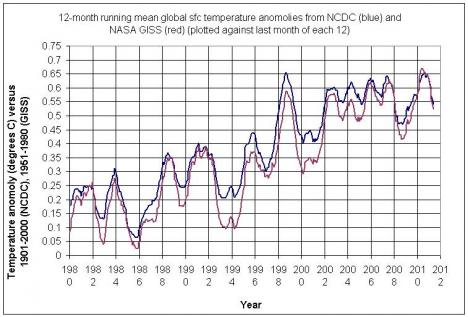
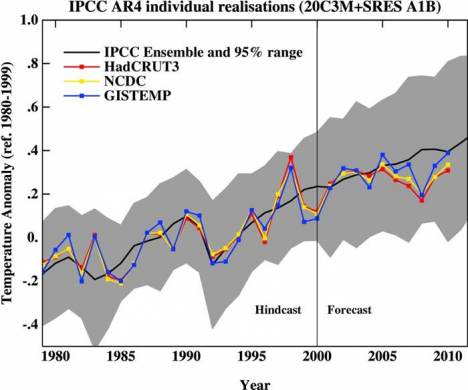
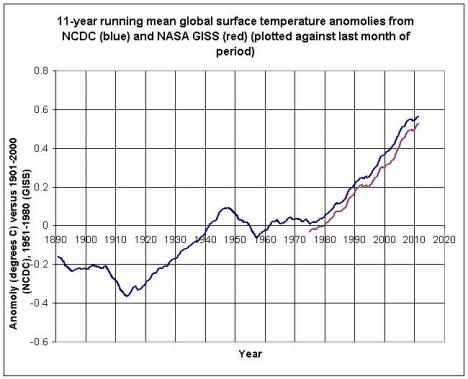
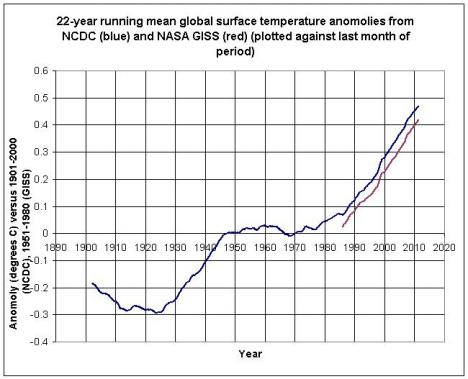
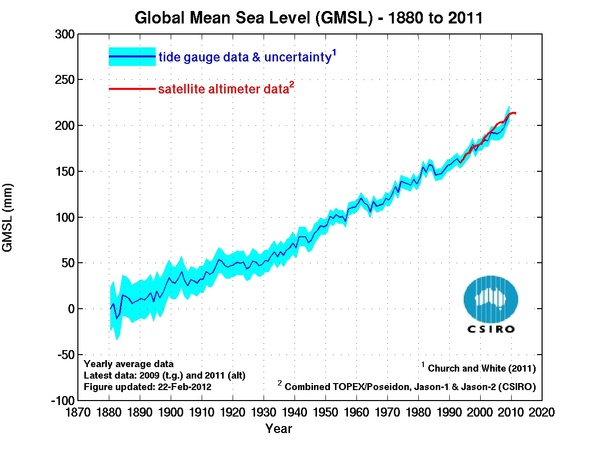
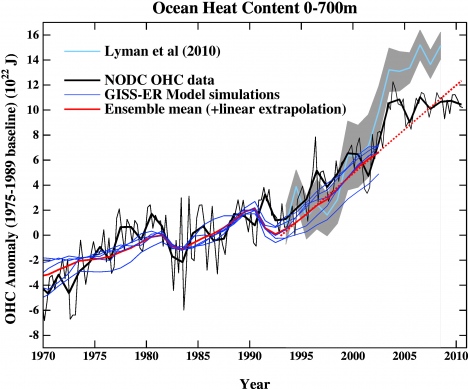
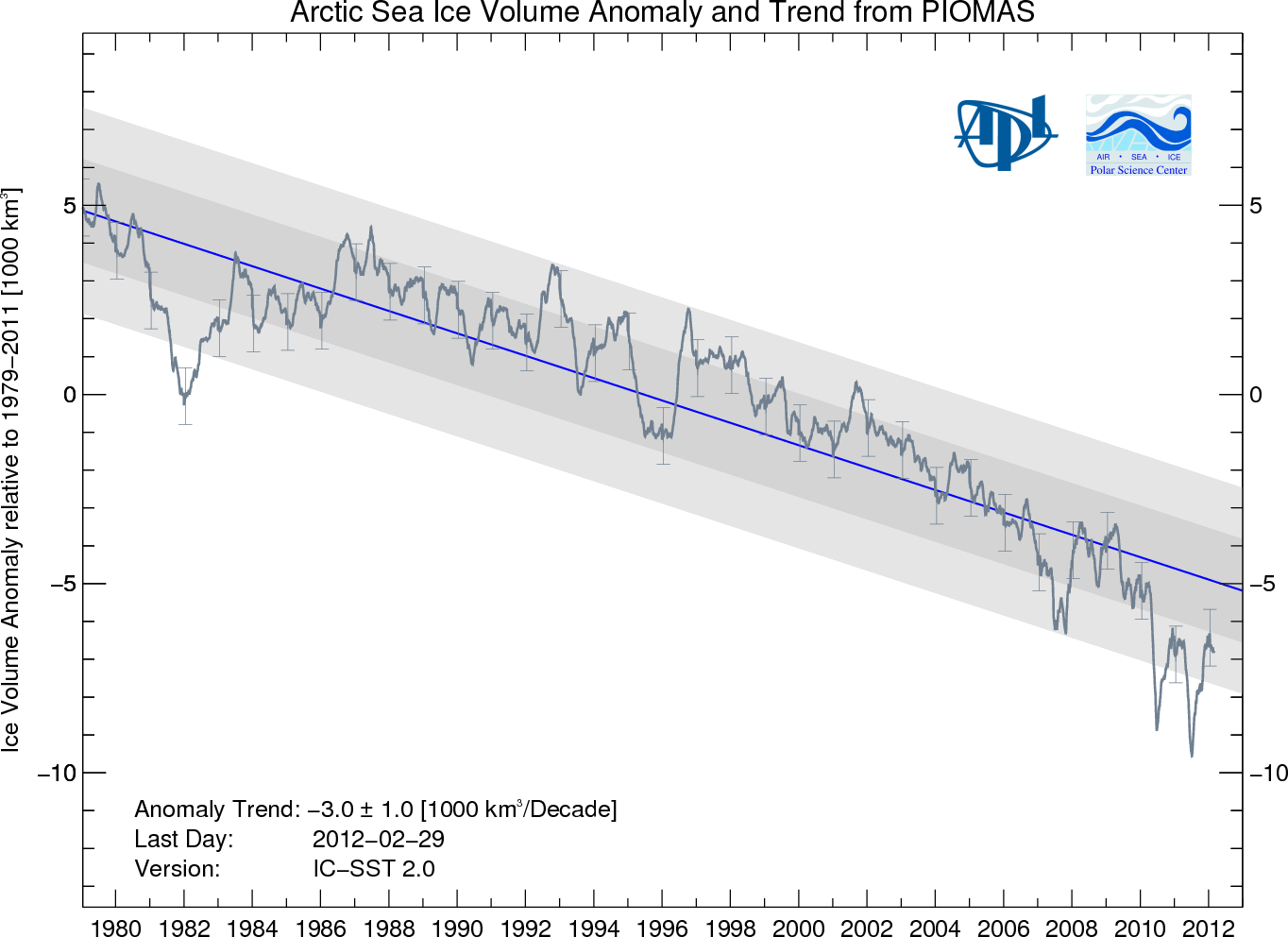
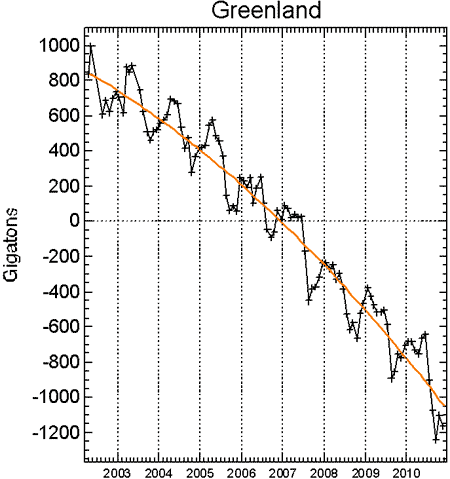
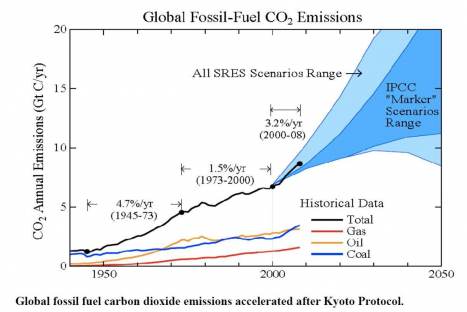
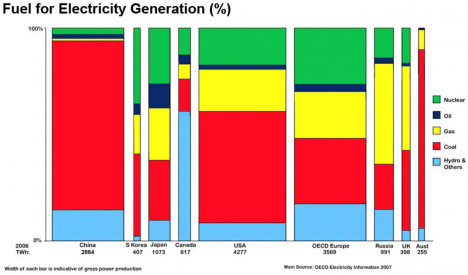
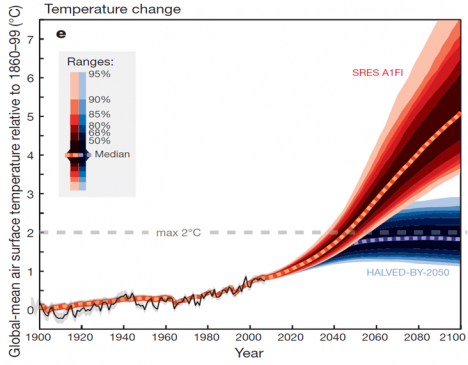
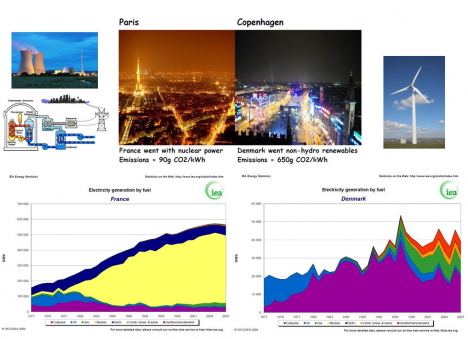






Well said, Barry! We have little time left to change — and so, lets get on with it. Dan
Great visual update.
The only thing I’d recommend is changing the Fuel for Electricity Generation (%) figure, and having individual percentages for hydro and “others”.
Cheers.
Thanks for bringing all this together for us. Very interesting.
I think Herr Professor Hans is not a convincing argumentor.
Common sense dictates one compares air temperature with… air temperature. Maybe it’s 18 °C outside. If it goes up by two degrees, to 20 °C, no one notices without a thermometer. If it goes up by four degrees, to 22 °C, it’s slightly nicer.
Obviously a straightforward ΔT and its effect on the human body isn’t the issue. But rather then try to explain the real issue, Herr Professor insults our intelligence with clearly-contrived polemics.
70 meters over how many thousands of years? Melting Antarctic ice sheets are obviously the least important of climate change effects, even if they are easy to calculate.
Not surprised to find this Herr Professor is a shrilly shreaking anti-nuke:
http://www.spiegel.de/international/germany/0,1518,752474,00.html
Also a Greenpeace-school neoluddite who wants to restrict humanity’s energy consumption, regardless of GHG emissions. He wants world governments to “stabilize” energy consumption to a more “reasonable” level? His solutions are even more destructive than the problem.
The lower SRES emissions scenario shows a turning point around 2030. This a sobering thought even for those who dispute AGW since it means renewables, efficiency and whatever else will have to increasingly carry the load as all fossil fuels decline.
http://en.wikipedia.org/wiki/Special_Report_on_Emissions_Scenarios
There will be more of us, we will want a more equitable distribution of material wealth and replacements for many energy sources (e.g. liquid fuels) will not be as convenient.
Uvdiv, in the analogy, core body temp is like global averaged T. Your local alternative is more akin to the skin T of your little finger.
I make no comment on Schellnhuber’s views on electricity generation!
Well you could try to retroactively repair the analogy, but I still think it’s just bad presentation, bad scientific communication.
I thought it was very powerful/effective, which is why I used it. Horses for courses I guess.
Hi Barry,
Thanks for keeping up the fight to kickstart the energy revolution in Australia. You are one of the best and most effective communicators on the issue on the pro-action side. I am pessimistic as to whether the Australian people will accept change, such as the CO2 tax, however, as while the PM is obviously a great negotiator and has the right intentions her communication is too carefullt worder at times and does not get through to many people.
My concern also is that we do not only need to revolutionise the energy system with nuclear and renewables now but considering that it is thought that sulphur pollution has cancelled out some of the warming effect of CO2 over the last decade (Kaufmann et al. 2011) we also need to consider replacing the sulphur with an equivelant substance when China and India start to rapidly clean up there factories and power stations? Any thoughts on this?
This is an analogy. As such is it of course not true when taken literally.
On the other hand, 4 degrees more is seriously bad news, in both cases. So I agree with Barry Brook that this is an interesting way of wording the wake-up call.
(Comment deleted – violation of the comments policy. BNC no longer posts or discusses comments by sceptics of the consensus science on CC/AGW)
(Comment deleted – violation of the comments policy. BNC no longer posts or discusses comments by sceptics of the consensus science on CC/AGW)
I think that you should put this next to the website banner !
MODERATOR
It is up to you to read the Comments Policy on the About page before posting.
uvdiv, I disliked the prof’s analogy too (not that I can think of anything better, mind you)… however, on the matter in hand – that of AGW – you are (presumably) both on the same side, don’t forget!
Another glimpse of the future: http://www.themercury.com.au/article/2011/07/13/245251_tasmania-news.html
A reminder to commenters to observe BNC’s new policy on CC/AGW scepticism:
Barry Brook, on 13 July 2011 at 5:16 PM said:
“I thought it was very powerful/effective.”
I agree, indeed, I came here tonight with the intention of recounting the analogy.
I have already used it in discussion with two people today. Both agreed it helped them understand how it was possible for seemingly small global temperature changes to have such profound effects.
What are the Argo buoys saying?
uvdiv & Bean,
I did not like the body temperature analogy either. However, in a general sense, you think of the body as an ecosystem that is evolved for a certain temperature range. Push it outside that range for a long enough period and bad stuff happens. That is also true for the earth. The Prof’s error is actually using values which are different for the body and for the earth.
[…] […]
Read “Living in Denial” by Mrs. Dr. Kari Marie Norgaard, 2011, MIT. From:
http://dotearth.blogs.nytimes.com/2011/04/28/on-birth-certificates-climate-risk-and-an-inconvenient-mind
…………….
“Rather, the knowledge brings about unpleasant emotions and anxiety. Individuals and communities seek to restore a sense of equilibrium and stability, and thus engage in a form of denial which, although the basic facts of climate change are acknowledged, the logical conclusions and actions that follow from the information are minimized and not acted upon. This perspective calls for a much different approach to climate change communications, and defines a new agenda for this field.”
(Comment deleted. Violation of the Comments policy)
Deny, delay, and dismiss… do any of the rejectionist arguments fall outside those three categories?
Deny: “it’s not happening”
Delay: “more research is needed”
Dismiss: “if it is happening, then it’s a good thing”
We can know what is effective by what is attacked most vehemently.
The plot of Global CO2 emissions show a rising overall rate and also a rising global rate of CO2 emissions FROM COAL.
Questions:
What country/countries are responsible for the rising rate of coal emissions???
I think it is China., but not sure.
We know China has very ambitious goals for getting Nuclear on line.
so Question 2 is:
Have China’s projected Nuclear increase been factored into the forecast for Global emissions.
Question 3:
What increase in Nuclear is assumed for Australia in the forecast???
Thx,
GSB
Also, China is run by rational technocrats , so there is hope that CCS will be developed and applied over there. Plus of course their nuclear build.
(Comment deleted. Violation of the Comments policy.)
MODERATOR
I repeat – BNC no longer posts or discusses comments by sceptics of the scientific consensus on CC/AGW.
China appears committed to generation IV nuclear.
http://itheo.org/articles/china-announces-thorium-energy-project
MODERATOR
Off topic on this thread – please move to another relevant thread or the Open Thread
Thx TerjeP I read the link ..
looks like just a -one off -thorium experiment.
But definitely in the right direction. Somebody has to do something.
I am VERY disappointed in the Japan PM coming out on the negative side today wrt Nuclear.
MODERATOR
Off topic on this thread. TerjeP has been advised the same. Please move to a relevant or Open Thread.
Thx Moderator,
Then I would just ask about the assumptions used in the Model:
Here are my questions:
The plot of Global CO2 emissions show a rising overall rate and also a rising global rate of CO2 emissions FROM COAL.
Questions:
What country/countries are responsible for the rising rate of coal emissions???
I think it is China., but not sure.
We know China has very ambitious goals for getting Nuclear on line.
so Question 2 is:
Have China’s projected Nuclear increase been factored into the forecast for Global emissions.
Question 3:
What increase in Nuclear is assumed for Australia in the forecast???
Thx,
GSB
(I count myself as a science-loving advocate for our planet. The material I bring to bear is as rock-solid as I can find, which perhaps is one reason our esteemed leader has found no issue with the evidence I’ve brought in the past. My goal is not only to solve the climate/ecological challenges, but to do so without destroying our planet in the process through engineering mistakes brought on by overconfidence in patterns that do not point to viable solutions.)
I trust that this is still a science-oriented site, with appreciation for the truth, even though there’s no more room for discussion of the evidence.
To that end I hope you’ll correct or explain, at least briefly, how the statement “we are now well and truly heading for the red zone in this forecast” connects to the data in the referenced graph, which has just dropped out of the bottom of the red zone.
I also suggest incorporating the latest findings on volcanic aerosols into your perspective: apparently, our understanding may well have been off by several orders of magnitude.
http://www.pnas.org/content/early/2011/06/30/1104923108.abstract
MODERATOR
There is still room for discussion on BNC of the evidence for/against AGW/CC as long as that evidence is backed up by peer-reviewed articles from respected science journals.
It’s just an analogy guys – a “similarity in some respects between things that are otherwise dissimilar”. The similarity being that a seemingly “small change” can be very detrimental.
Some people have it in their head that climate change can’t be that bad, because the change is “only small”. This is absolute nonsense. A small change in body temperature can be harmful (lethal), as can a small concentration of arsenic in the human body, or a small increase in the concentration of chlorofluorocarbons in the stratosphere where they deplete ozone.
MrPete, aerosols are a short-term forcing effect, they are not long-lived (whether they come from volcanoes or coal-fired power stations). That is, we (or nature) have to keep putting them up into the atmosphere, or else they are washed out within days to weeks. GHG like CO2 have a residence time of decades to centuries to millennia. The PNAS paper you linked to refines our understanding of the effect of the short-term cooling offset of aerosols. It is a different matter to climate change.
I wrote a post about this on BNC a while back that you may not have seen:
How much warming in the pipeline? Part II – it’s as tricky as ABC
“I wrote a post about this on BNC a while back…”
– Thanks!
I was at the four degrees conference this week. All very gloomy stuff I’m afraid. Australia will still be some sort of first world country in a hot future, but our neighbours across the sea will be basically ruined, I can’t see them maintaining civil society.
Subsistence fisherfolk will be amongst the first victims.
Barry, the graphs are compelling. For the record, my position on climate change has gone from strong skeptic a couple of years ago to scared for the future my kids are growing into. Your site has become one of my favourites. My background is in geology and environmental science. I can tell you though that there are a lot of skeptics in the geological fraternity which is based on the geological record of large changes in climate and sea levels. There is a tendency to talk down the graphs you have presented as possible under natural processes. I am interested in sourcing specific articles from those more qualified than myself that specifically put this assertion to bed. I am interested in preparing some posts and short articles for trade magazines and publications. I see a lot of value in specifically arguing this point effectively as the likes of Bolt etc fall back on it frequently. I see value in going back to the underlying physics that underpin predictions to reinforce these graphs when speaking to a skeptic who has some grasp of science.
Rick, there are plenty of primers out there, from the most basic to fairly advanced. Geologists are right that of course there have been greater changes in the past, the world has been both far hotter and far cooler than now. But it’s hard to accept that the changes have been as fast in the past (hard to tell fro the geological record, but seems to be that way) and human fingerprints are all over this problem – the isotope ratios tell us that all the extra CO2 up there is definitely our fault. Ockhams razors cuts skeptical argumetns to ribbons – what else is the CO2 doing up there, if not put there by us, and heating the planet?
@George Bower
‘looks like just a -one off -thorium experiment.’
Not sure why you reach this conclusion. This is one of 4 major ‘strategic leader in science and technology projects’. It is headed by a Vice-President of the Chinese Academy of Sciences (who happens to be the son of the former President of China, Zhiang Zemin).
We’ll have to see how far this goes, but I don’t think we should write this off as a lark.
Thank you Barry Brook, for the presentation of some interesting data. I have done some calculations and have some observations and questions based on the data.
First, a question: The twelve month running mean graph is for the temperature anomaly from the 1951-1980 baseline average (GISS). How much above pre-industrial temperature is the GISS 1951-1980 baseline? I’ve never seen a value for this, but I estimate that the GISS 1951-1980 baseline is 0.4°C above pre-industrial. Do other posters have a different value?
Second, looking at the 12 month running mean graph, I roughly estimate a 0.15°C per decade temperature increase over the past 4 decades, with a recent average temperature anomaly of ~0.6 °C. The current temperature is roughly then about 1.0°C above pre-industrial. Using the 11 year running average from 1980 to 2010 graph data, the temperature increase has been linear over four decades at ~0.17°C per decade.
Third, I believe that many groups believe that it is crucial to limit temperature increase to 2°C over pre-industrial. That then leaves us with 1.0°C to go….. or about 60-65 years at the 0.15 to 0.17°C per decade temperature increase rate.
Fourth, the 0-700 m ocean heat content graph shows about a 15E22 Joule increase in ocean heat content (both NODC and ensemble mean) over the 40 year period 1970 to 2010. My best estimate is that the 0-700m ocean heat uptake is roughly 2/3rds of the total earth heat uptake. In terms of radiative forcing, the total earth heat uptake is then about 0.47 w/m2. Compare that with the UN IPCC GHG 2005 radiative forcing of 2.6 w/m2. This indicates that the effect of ocean heating is significant but minor compared to GHG forcing. There is no huge ocean heating effect masking temperature increase.
Finally, the global CO2 emissions graph shows CO2 emissions increasing at a rate of 4.7%/yr from 1945 to 1973, 1.5%/yr from 1973 to 2000, and 3.2%/yr from 2000 to 2008. Contrast that data with the increase in atmospheric CO2 ppmv of 0.20%/yr from 1945 to 1973, 0.43%/yr from 1973 to 2000 and 0.52%/yr from 2000 to 2008. Atmospheric CO2 is not going up as fast as one might think from the emissions data.
Barry, I suggest touching on how we can say there’s most likely a trend in a data set. The best clear explanation I’ve found is Robert Grumbine’s site.
With so many questions, people need to understand what “a trend” or “an effect” means statistically — having enough numbers, enough data, enough time, enough measurements, to know how much natural variation there is in the “control” group, so it’s possible to apply the treatment or find an affected group or time span, drop out that natural variability and assess whether there’s anything left suggesting a trend exists due to the treatment — CO2, radiation, whatever treatment.
Here’s a link to one of several of Grumbine’s topics; note he has more information and data sets on his site and encourages people to take the concept and work out the answer themselves.
http://moregrumbinescience.blogspot.com/2009/01/results-on-deciding-trends.html
Excerpt follows:
——-
In brief (in a journal paper, this would be the ‘abstract’):
You need 20-30 years of data to define a climate trend in global mean temperature
Forward and backward trends are markedly different
Therefore, to discuss climate trends in global mean temperature, you need to use 20-30 years of data centered on the date of interest.
As with any abstract, it’s too brief to show you why any of these are true, just some simple declarations. Now, if you trust me absolutely (which I don’t recommend — and if I’m talking science, you don’t need to), you can stop and move on to some other reading. But let’s take a look at the whys. As before, I’m putting the data and programs on my personal web site and you can run the analysis yourself, and modify the programs to work on different assumptions, methods, data sets.
Let’s consider the first point — how long it takes to determine a climate trend in global mean temperature. We could define a trend with 2 minutes of data — temperature at one minute, temperature at the next minute, and draw a straight line through the two numbers. We’d wind up with wildly varying trends, though, from minute to minute through the year. This is weather and turbulence. Make it daily or monthly averages, and we still have the wildly varying trends, and the magnitude of those trends will depend on what time period we chose. Rather than declare that ‘this is the right period’, we’ll determine it by looking at the data itself.
If it is meaningful to talk about climate as opposed to weather, there has to be a time span over which our result for describing climate does not depend much on how long a time span we choose. For average climate temperature, we found 20-30 years as the appropriate time span. I didn’t show the figures then, but it’s in the program and output you can pick up from my web site that this is also the appropriate time span for deciding a climate temperature variance (how much scatter there is about the average; even if the average didn’t change, we would probably consider it a climate change to have winter lows vary from -30 to +15 instead of -10 to -5)….
—- end excerpt —-
Statistics is the only tool we have good for telling us whether there’s a small signal or small effect in a noisy data set. It’s what we have to get us past expressing our fervently held wishes and beliefs.
Also relevant to the subject, from another science site in the Blogroll:
http://tamino.wordpress.com/2011/07/16/trend-and-noise/#comment-52417
— excerpt follows, you need to read the whole post to undestand —
“it might at least be possible that 10 years’ data would have enough information to tease the trend out from the noise — after all, statistics is a powerful tool for finding real trends in spite of sizable noise. Is there a way to estimate the limits of what the actual trend might be, even for noisy data?
Yes, there is.
When you estimate the trend using linear regression on actual data, not only can you compute the trend estimate, you can also compute the uncertainty in that estimate. However, one must be careful …”
@Hank Roberts
Steady up Hank! I don’t “often delete” your posts, although I do sometimes edit them as per BNC rules. If I do you(and others) are always informed of the deletion/editing and the reasons why this has occurred. Your current comments have been moved to Pending,(as is the case with any complex comment where I am unsure) in case Barry wants to answer your questions. He will deal with them when he comes on to the blog. Any comments that I think need deleting are moved to Trash(commenter is notified with reason given) and Barry is the only one who deletes the trash. He always has the last say.
I may as well state here I’m agnostic on AGW ie I don’t share the alarm of ‘The Team’ as M&M, etc would categorise them and believe they’ve been engaging in advocacy science to some extent, probably to the detriment of neutral(ie traditionally skeptical) scientists in the field. However I have no time for the failed IPCC/Team/Greenpeace policy prescriptions to date which might naturally colour my view of their science. That said I can more readily respect Barry’s view of the science because of his more rational view of what I call the ‘reshiftable energy’ policy malaise. Owning a 2.1kW solar feed-in system simply for its 9-10% risk free, after tax return, compliments of my fellow taxpayers and power bill payers does colour one’s judgement as to the efficacy of renewables and if it’s not to be carbon fuels, that leaves me firmly with Barry on nuclear.
Watching a 2.1kw solar system putting out 40-50W at midday on a wet overcast day with no wind about leads to a logical conclusion. Furthermore I know such systems are about 15% efficient in converting what sun falls on them into electricity (Sanyo claim world’s best at 18% out of the inverter at present) Then it’s a simple matter to model the Green pipedream of 100% efficiency, whatever the cost. Simply divide 100 by 15 to get 6.67 and use that factor on current outputs. Unfortunately zero times anything is still zero and that 40W becomes 267W. Sure 1800W in bright sunshine around 24degC jumps to 12kW but all that does is exacerbate the extreme volatility of installed solar capacity with more headaches for whatever baseload. That leads me to conclude anyone who says solar is the future is ignorant, delusional or lying about the facts. Still like true scientists you may want to verify the facts and no better place than here-
http://htpc.avenard.org/power/about
Check out the various menus and pay particular attention to that annual daily graph with its peaks and troughs compared to the average monthly one on which its owner gets paid like me (I gather he has a swimming pool and runs the pump/filter at night naturally) Remember also that behind that horrid annual daily graph of spikes and troughs lies the extreme minute by minute of the day variability. This is the stuff Green wet dreams.
OK, I see the two posts now have been approved. Thank you Barry.
In my opinion, the Global Warming Community’s program is based on four beliefs. These are:
1. The global climate has been and is continuing to get hotter since the start of the industrial revolution. This warming is caused by “greenhouse gases” (GHG are mainly CO2 but also CH4, N2O, and halocarbons, etc) emitted by our industrial and agricultural societies. The warming due to GHG is a scientifically established fact based on IR radiative forcing.
2. When global warming goes above X °C over the pre-industrial average temperature, the result will be an existential catastrophe for all life on Earth, with severe climatological, ecological, agricultural, health and economic consequences for the human race. The limit of X °C can be determined by scientific and ecological studies before the temperature limit is reached.
3. The amount of GHG emissions needed to reach the X °C temperature limit can be calculated using computer General Circulation Climate Models. The amount of GHG in the atmosphere can be characterized by the concentration of Y ppmv CO2 that results in the global temperature increase of X °C.
4. To avoid the existential global warming catastrophe, a world-wide governmental agreement is required to limit every country’s GHG emissions such that the global CO2 concentration is held at or below Y ppm CO2, thus avoiding warming over X °C. Limits on a country’s GHG emissions can be achieved through governmental restrictions, regulations, subsidies and/or taxing of energy (fossil fuel and other) and of forestry and agricultural practices.
Following the spirit of Barry Brook’s “Climate change by the numbers”, in this post, items 1 and 3 are partially examined through use of 130 years of global temperature and GHG data along with 55 years of ocean temperature data. The data used is that generally accepted by the Global Warming Community and sources are referenced.
Various political bodies have weighed in on what X °C is. Two degrees Celsius is the limit set by The EU Commission in Jan 2007, by the G-8 in July 2009 and at the UN Copenhagen and Cancun meetings in Dec 2009 and 2010. Some think this is not enough, that the limit should be 1.5 °C and some think the 2°C limit is too stringent (and also unachievable).
The Worldwatch Institute’s State of the World 2009 says (page 18): “ Efforts to define acceptable limits to warming at a political level started in the European Union and among its member states. Based on the IPCC’s Second Assessment Report at the end of 1995, the European Union’s Council of Environment Ministers in 1996 called for warming to be limited to 2 °C above the preindustrial level.”
So the question is: What is the GHG or CO2 Y ppmv limit that will limit Global Warming to 2 °C?
I think the best way to answer this is to use an Excel spreadsheet to investigate the relationships between global average temperature and CO2 and GHG. This can be done by regressing temperature against CO2 (or GHG) radiative forcing. Radiative forcings are the scientifically correct approach for accounting of infra-red absorption and re-radiation by greenhouse gases. The equation for the temperature increase ΔT, °C for a radiative forcing of ΔF w/m2 is:
ΔT = λ∙ΔF °C Eqn #1
where lambda λ is the climate sensitivity parameter with units of °C/(w/m2).
For CO2 the radiative forcing for Y ppmv is:
ΔF = 5.35 ln(Y/278) w/m2 Eqn #2
where 278 is the pre-industrial CO2 concentration of 278 ppmv.
James Hansen, the noted climate researcher, has 130 years (1880 to 2010) of annual global mean temperature data on http:// data.giss.nasa.gov/ (see GISS Surface Air Temperature Analysis). The data is presented as global LOTI, the global land-ocean temperature index. LOTI is the global mean temperature anomaly from the base period 1950-1981, when the average global land-ocean surface air temperature was 14.0 °C. In 2010, the global LOTI was 0.63 °C. In 1880 it was -0.25 °C
Data for CO2 at Moana Loa Hawaii from 1959 to 2010 can be found at http://www.esrl.noaa.gov/gmd/ccgg/trends. To cover the period before 1959, Law Dome Antarctica CO2 data is available at http://www.ncdc.noaa.gov/paleo/metadata/noaa-icecore-2455.html. The 20 year smoothed CO2 data runs from before 1880 to 1978. The Law Dome and Moana Loa data overlap from 1959 thru 1978. Comparing the overlap indicates that Law Dome 20 year smoothed CO2 plus 0.7 ppmv equals Moana Loa CO2. CO2 in 1880 was 291 ppmv and in 2010 CO2 was 390 ppmv.
Entering the global temperature index and CO2 data into an Excel spreadsheet allows temperature and CO2 relationship to be explored. If one plots the temperature index vs CO2, it is possible to estimate the global LOTI at the pre-industrial concentration of 278 ppmv CO2. The LOTI found is -0.40. Therefore, to adjust LOTI to warming above pre-industrial, 0.40 °C is added to LOTI. So in 2010, the global mean temperature ΔT was 0.63 + 0.40 = 1.03 °C warmer than pre-industrial.
In the spreadsheet, the CO2 radiative forcing ΔF can be calculated from the CO2 concentration and plotted vs the ΔT temperature increase over pre-industrial (LOTI plus 0.4 °C). When the 130 years of data is regressed, the equation for ΔT is: ΔT = 0.548* ΔF-0.02 °C, with an R squared of 0.821. This is corresponds well with Eqn #1 since the constant term -0.02 is nearly zero as predicted by Eqn #1.
For a CO2 level of 450 ppmv, the ΔF is 2.58 w/m2 and the regressed CO2 radiative equation predicts a ΔT of 1.4 °C, and a ΔT of 2.0 °C for a CO2 concentration of 550 ppmv.
This approach can be extended to the greenhouse gases CH4, N2O and halocarbons by the information at http://www.esrl.noaa.gov/gmd/aggi/ . Data for atmospheric concentrations of CH4, N2O and various halogenated gases are presented, along with the radiative forcing equations for these GHG. At present, the CH4 concentration is 1800 ppb, N2O is 324 ppb compared with pre-industrial concentrations of 700 and 270 ppb respectively.
When the ΔT data is regressed against total GHG ΔF, the resulting equation is ΔT = 0.320* ΔF + 0.01 °C with an R squared of 0.817. When CO2 is 450 ppmv, CH4 is estimated at 1790 ppb and NO2 at 342 ppb with halocarbon radiative forcing of 0.34 w/m2, about what it is now. The total GHG ΔF is 3.65w/m2 and ΔT is 1.2 °C. At 550 ppmv CO2, I estimate ΔT is 1.5 °C.
One certain critique of this approach is that ΔT calculated is a then current temperature increase, and does not account for equilibrium effects of the GHG heating of Earth’s oceans. Ocean heating data for 0-700m is available at http://www.nodc.noaa.gov/OC5/3M_HEAT_Content. The methodology for including ocean heating can be found in Trenberth’s
http://www.cgd.ucar.edu/cas/Trenberth/trenberth.papers/EnergyDiagnostics09final2.pdf
When I include ocean heating effects (estimated at 0.26 w/m2 average from 1955 to 2009), then I get an equilibrium ΔTe about 10% higher than the ΔT’s estimated above.
I have purposely refrained from justifying the methodology or interpreting the results presented. I would encourage interested parties to try to do calculations similar to what I have described and compare results or critique my approach.
Leo, the uncertainty bounds for climate sensitivity is 2 to 4.5 C, which a median estimate of about 3.2 C. That is an equilibrium sensitivity, so will not be the instantaneous effect, as there are various lags to play out (including ocean heat dissipation) and slow feedbacks. Your calculation, being a regression on past data, is only including feedbacks that were already realised over that period — including -ve aerosol forcing.
Well done Barry! As a Swiss-American, I also believe that nuclear must be a part of our energy future, and as a Sustainability Designer believe that we can harness nuclear FUSION with the efficient capture of all the renewable energy that comes to us from the sun!
Please view my design projects at http://www.greenmillennium.eu We just have to start early enough, and time is already pressing! My approach has been to combine existing solutions AND future requirements to construct Linear Cities that will provide Energy, Food and Transportation 100% sustainably!
Please view, comment and improve on the projects – that’s why they’re there!
Let’s go, for the sake of the components of our children’s genes – the only scientifically provable form of eternal life – those components will still be around in 2000 years (as long as we have children), but will they have affordable food, energy and transportation? Only if we begin to build 100% sustainably ASAP!
(Comment deleted – ‘climate change isn’t happening’ debates are no longer posted or discussed on BNC – see comments policy)
This page has a brief summary of the many different ways that have been used for getting a climate sensitivity number (a “probability distribution function” aka “PDF” is a curve showing the range from low to high with the most likely number somewhere in the middle of the chart).
http://julesandjames.blogspot.com/2006/03/climate-sensitivity-is-3c.html
A good brief blog explanation of the calculations:
“The whole debate comes down to: what is the magnitude of the effect. For simplicity, I’ll just talk about the “climate sensitivity”….
… doubling the amount of CO2 in the atmosphere, IF NOTHING ELSE CHANGED, would increase the temperature by between 1C and 2C….”
( -> that’s the “instantaneous effect” that Barry describes above)
“But nobody thinks that nothing else would change….
… This simple calculation is good for some purposes, but it’s limited in what it can tell you. ”
http://www.stat.columbia.edu/~cook/movabletype/archives/2009/12/say_a_little_pr.html
@ Hank Roberts: I do have a reply to your post, it is based on my two posts above. However I have been prevented by the Moderator from posting any comments. This has happened multiple times.
MODERATOR
The only comments you have been prevented from posting are those which seek to deny the scientific consensus on AGW/CC. Barry has notified all commenters that henceforth no such comments will be posted or discussed on BNC (check Comments Policy on the About page) and does not apply to you in isolation. As always Barry has the final say in what is deleted and obviously he has decided to delete those comments from you which violate that part of the BNC Comments Policy
[…] it continues to get hotter. Brave New Climate has a post on the numbers with a good set of graphs, Hot Topic reports that the Arctic is still melting as […]
Climate scientists are generally calling for the concentration of CO2 in the atmosphere to be reduced to 350 ppm per million if global warming is to remain below two degrees in this century.
This figure is useless for policymakers though. What they need to know is the maximum allowable CO2 release in all sectors of the economy per capita per year, backed up by reliable data on cumulative supply chain emissions and so on.
So what is a safe figure in a world of 7 Billion people? What is safe in a world of 9 Billion people? Is it 2 tons … or 1 ton … or less?
The human body temperature analogy is pertinent, compare it to the average global temperature. If you still don’t like it change it from the internal body temperature to the air temperature that induces heat stroke and death. The amount of rise necessary is small in the big picture and only has to peak once per person.